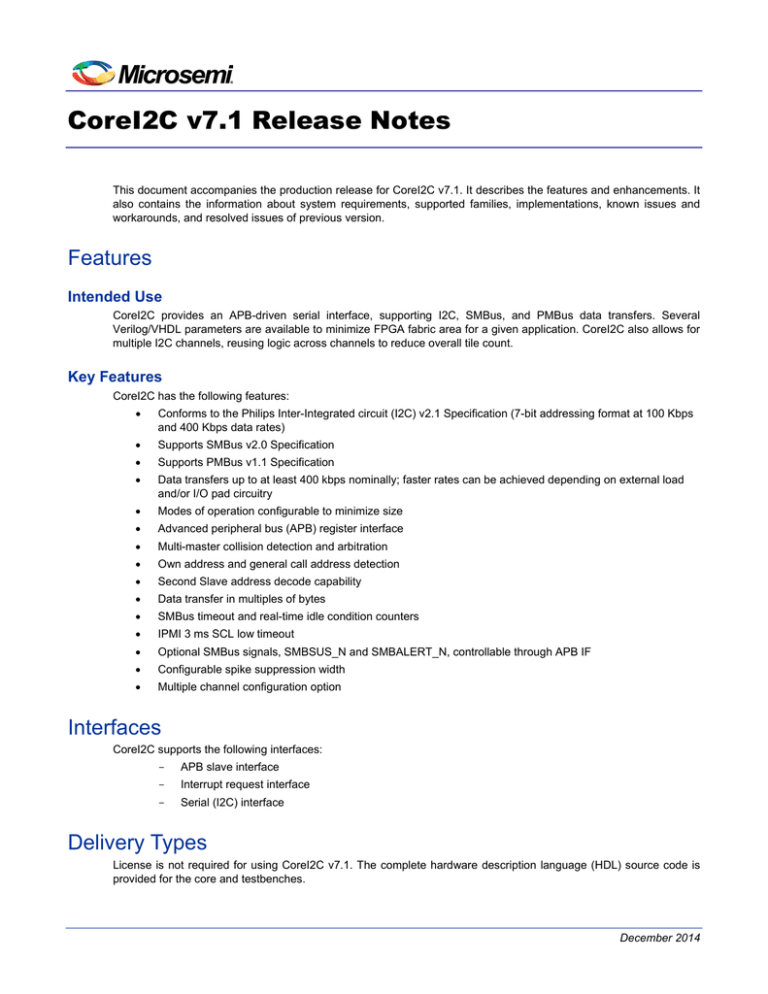
CoreI2C v7.1 Release Notes
This document accompanies the production release for CoreI2C v7.1. It describes the features and enhancements. It
also contains the information about system requirements, supported families, implementations, known issues and
workarounds, and resolved issues of previous version.
Features
Intended Use
CoreI2C provides an APB-driven serial interface, supporting I2C, SMBus, and PMBus data transfers. Several
Verilog/VHDL parameters are available to minimize FPGA fabric area for a given application. CoreI2C also allows for
multiple I2C channels, reusing logic across channels to reduce overall tile count.
Key Features
CoreI2C has the following features:
•
Conforms to the Philips Inter-Integrated circuit (I2C) v2.1 Specification (7-bit addressing format at 100 Kbps
and 400 Kbps data rates)
•
Supports SMBus v2.0 Specification
•
Supports PMBus v1.1 Specification
•
Data transfers up to at least 400 kbps nominally; faster rates can be achieved depending on external load
and/or I/O pad circuitry
•
Modes of operation configurable to minimize size
•
Advanced peripheral bus (APB) register interface
•
Multi-master collision detection and arbitration
•
Own address and general call address detection
•
Second Slave address decode capability
•
Data transfer in multiples of bytes
•
SMBus timeout and real-time idle condition counters
•
IPMI 3 ms SCL low timeout
•
Optional SMBus signals, SMBSUS_N and SMBALERT_N, controllable through APB IF
•
Configurable spike suppression width
•
Multiple channel configuration option
Interfaces
CoreI2C supports the following interfaces:
-
APB slave interface
-
Interrupt request interface
-
Serial (I2C) interface
Delivery Types
License is not required for using CoreI2C v7.1. The complete hardware description language (HDL) source code is
provided for the core and testbenches.
December 2014
CoreI2C v7.1 Release Notes
Supported Families
•
IGLOO®
•
IGLOOe
•
IGLOO PLUS
•
ProASIC®3
•
ProASIC3E
•
ProASIC3L
•
Fusion
•
ProASICPLUS®
•
Axcelerator®
•
RTAX-S
•
SmartFusion®
•
IGLOO®2
•
SmartFusion®2
•
RTG4™
Supported Tool Flows
Libero v9.1 or later software supports CoreI2C v7.1
Note: CoreI2C is compatible with both Libero Integrated Design Environment (IDE) and Libero System-on-Chip
(SoC). Unless specified otherwise, this document uses the name Libero to identify both Libero IDE and Libero
SoC.
Installation Instructions
The CoreI2C CPZ file must be installed in Libero. This is completed automatically through the Catalog update
function in Libero, or the CPZ can be manually added using the Add Core catalog feature. Once installed in the
Libero catalog, the core can be instantiated and configured.
Refer to the Using DirectCore in Libero IDE User Guide or Libero SoC online help for further instructions on core
installation, licensing and general use.
Documentation
This release contains a copy of the CoreI2C Handbook, which describes the core functionality, step-by-step
instructions on how to simulate, synthesize, place-and-route this core, and suggestions for implementation.
For more information about Intellectual Property, visit: http://www.microsemi.com/products/fpga-soc/designresources/ip-cores. For updates and additional information about software, FPGAs, and hardware, visit:
www.microsemi.com.
2
Supported Test Environments
Supported Test Environments
The following test environments are supported:
•
VHDL user testbench
•
Verilog user testbench
Known Issues and Workarounds
There are no known limitations or workarounds with the CoreI2C v7.1 release.
Release History
Table 1 provides the release history of CoreI2C.
Table 1 CoreI2C Release History
Version
7.1
7.0
6.0
Date
December,
2014
Changes
Added support for RTG4 family devices.
Resolved issue with disabling CoreI2C whilst SCL line low. CoreI2C no longer enters deadlock
when the core is disabled whilst the SCL line is low.
June,
2011
Interrupt generation after STOP bit is sent.
Nov. 2009
Remove 50 µs SMBus idle condition check (not required).
I2C slave 2nd address capability functionality corrected (SAR 30964). Operation details for Master
mode example updated.
2
Multiple channel mode, up to 16 I C/SMBus channels on a single APB interface.
Improved tile utilization.
5.0
Nov. 2008
Added the ability to further reduce tile count by hardwiring some configuration parameters.
Added IPMI SCL low timeout functionality.
Added second slave address capability.
Configurable spike suppression width.
4.0
Aug. 2008
Start hold timing violation corrected. Serviced many software action requests (SARs).
SMBus/PMBus functionality added to v4.0.
IGLOO/e device support added.
®
Added synthesis constraint to prevent Synopsys tile error when using FSM compiler.
Added Master Transmit and Slave Receive modes to reduce tile counts for write-only applications.
3.0
Nov. 2007
Switched from SFR to APB interface.
2.1
Jan. 2005
Discontinued support of Actel A54SX and eX families.
2.0
Aug. 2003
Initial release.
3
CoreI2C v7.1 Release Notes
Resolved Issues in the v7.1 Release
Table 2 lists the Software Action Requests (SARs) that were resolved in the CoreI2C v7.1 release.
Table 2 Resolved Issues in the v7.1 Release
SAR
Description
59782
Added SmartFusion2 and IGLOO2 to the supported families list.
60104
Added ProASIC3L to the supported families list.
57406
Added support for RTG4 family devices.
53359
Resolved issue with disabling CoreI2C whilst SCL line low. CoreI2C no longer enters deadlock when the core is
disabled whilst the SCL line is low.
Resolved Issues in the v7.0 Release
Table 3 lists the SARs that were resolved in the CoreI2C v7.0 release.
Table 3 Resolved Issues in the v7.0 Release
SAR
Description
25023
A pending Master Tx aborts (NACK) concurrent Slave Rx.
25400
SMBus Timeout Issue During Master TX/RX transaction.
25401
IPMI timeout issue during Master TX/RX transactions.
29537
Generate an interrupt after STOP bit is set.
30964
I2C slave 2nd address capability doesn't work.
Resolved Issues in the v6.0 Release
Table 4 lists the SARs that were resolved in the CoreI2C v6.0 release
Table 4 Resolved Issues in the v6.0 Release
SAR
Description
20288
Remove 50 µS SMBus idle condition check (not required).
Resolved Issues in the v5.0 Release
Table 5 lists the SARs that were resolved in the CoreI2C v5.0 release.
Table 5 Resolved Issues in the v5.0 Release
SAR
Description
78614
Fixed GlitchReg Value parameter.
78611
Required SMBus Optional Signal Interrupts.
78608
3 ms IPMI timeout required.
78610
IPMI extra Slave Address mode
78609
Fixed Slave Address mode for decreasing tile count
78613
Changed I2CCLK and I2CDAT signals to SCL/SDA.
78612
Fixed Baud Rate (saves about 50 tiles)
78560
The SMBUS signals float when not in use
4
Resolved Issues in the v4.0 Release
Resolved Issues in the v4.0 Release
Table 6 lists the SARs that were resolved in the CoreI2C v4.0 release
Table 6 Resolved Issues in the v4.0 Release
SAR
Description
78449
Device/family metadata issues - v4.0.106.
78444
Added synthesis constraint to prevent Synplicity tile error.
78443
Added SMBus functionality.
78220
CCZ verification: Synthesis warnings
77968
Request for a Master Transmit, Slave Receive mode to reduce tile counts for IPMI or any write-only application
77967
Start hold timing violation corrected.
69300
The handbook needs to describe the open drain I/O.
68890
CoreI2C simulation in Evaluation mode
68382
Utilization in VHDL is about two times that of Verilog.
68111
SPIRIT description missing link between APBslave i/f and RegisterMap
67496
CoreI2C shows up under non-AMBA bus list.
67475
The link to the datasheet for CoreI2C in CoreConsole does not work.
67474
Block diagram for CoreI2C does not show BCLK.
67450
CoreConsole does not generate C code for I C.
66806
Update the Data Transfers rate.
66574
Request to show the open drain configuration in the handbook.
65986
Data should be labeled PWDATA instead of PRDATA.
62885
Link to datasheet in core description is broken.
2
Resolved Issues in the v3.0 Release
Table 7 lists the SARs that were resolved in the CoreI2C v3.0 release.
Table 7 Resolved Issues in the v3.0 Release
SAR
Description
62412
An APB interface has been added and the SFR interface has been removed for use with CoreConsole in buscentric designs.
57330
The datasheet provided with previous versions of the core incorrectly described serdati as “serial clock input.”
The datasheet has since been superseded by a handbook, which accurately describes the serial data input
(I2CDATI).
5
Microsemi Corporation (Nasdaq: MSCC) offers a comprehensive portfolio of semiconductor
and system solutions for communications, defense & security, aerospace and industrial
markets. Products include high-performance and radiation-hardened analog mixed-signal
integrated circuits, FPGAs, SoCs and ASICs; power management products; timing and
synchronization devices and precise time solutions, setting the world’s standard for time; voice
processing devices; RF solutions; discrete components; security technologies and scalable
anti-tamper products; Power-over-Ethernet ICs and midspans; as well as custom design
capabilities and services. Microsemi is headquartered in Aliso Viejo, Calif., and has
approximately 3,400 employees globally. Learn more at www.microsemi.com.
Microsemi Corporate Headquarters
One Enterprise, Aliso Viejo,
CA 92656 USA
Within the USA: +1 (800) 713-4113
Outside the USA: +1 (949) 380-6100
Sales: +1 (949) 380-6136
Fax: +1 (949) 215-4996
E-mail: sales.support@microsemi.com
© 2014 Microsemi Corporation. All
rights reserved. Microsemi and the
Microsemi logo are trademarks of
Microsemi Corporation. All other
trademarks and service marks are the
property of their respective owners.
Microsemi makes no warranty, representation, or guarantee regarding the information contained herein or
the suitability of its products and services for any particular purpose, nor does Microsemi assume any
liability whatsoever arising out of the application or use of any product or circuit. The products sold
hereunder and any other products sold by Microsemi have been subject to limited testing and should not
be used in conjunction with mission-critical equipment or applications. Any performance specifications are
believed to be reliable but are not verified, and Buyer must conduct and complete all performance and
other testing of the products, alone and together with, or installed in, any end-products. Buyer shall not
rely on any data and performance specifications or parameters provided by Microsemi. It is the Buyer’s
responsibility to independently determine suitability of any products and to test and verify the same. The
information provided by Microsemi hereunder is provided “as is, where is” and with all faults, and the
entire risk associated with such information is entirely with the Buyer. Microsemi does not grant, explicitly
or implicitly, to any party any patent rights, licenses, or any other IP rights, whether with regard to such
information itself or anything described by such information. Information provided in this document is
proprietary to Microsemi, and Microsemi reserves the right to make any changes to the information in this
document or to any products and services at any time without notice.
51300009-6/12.14



